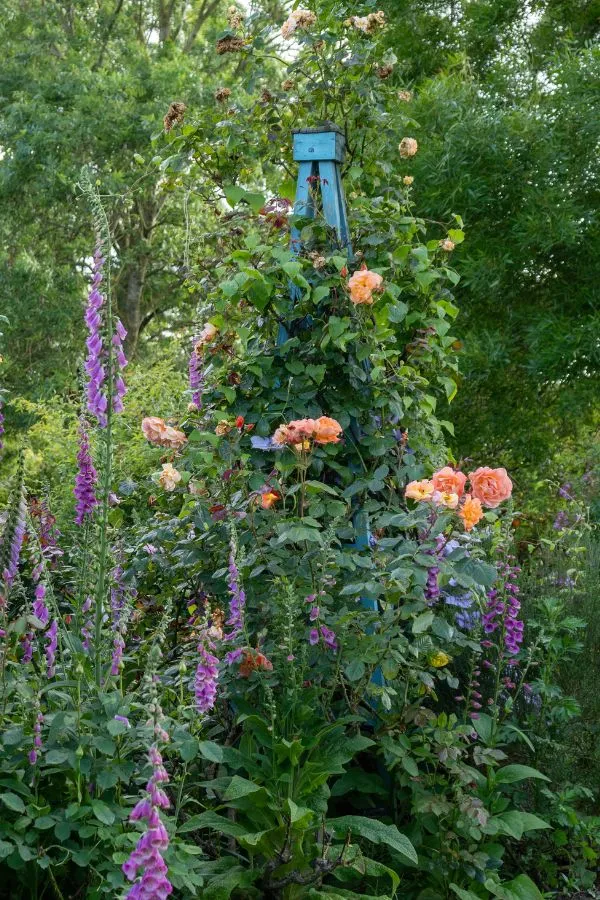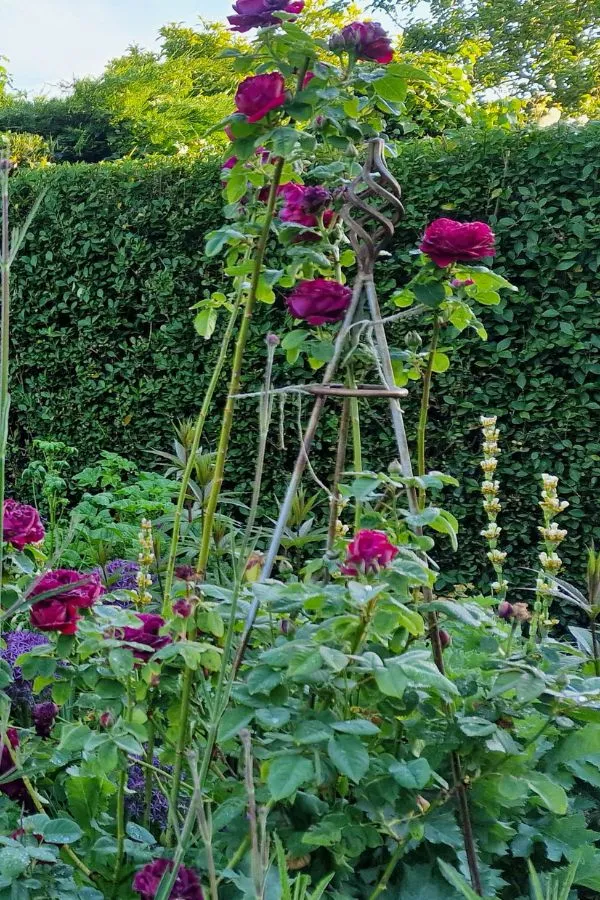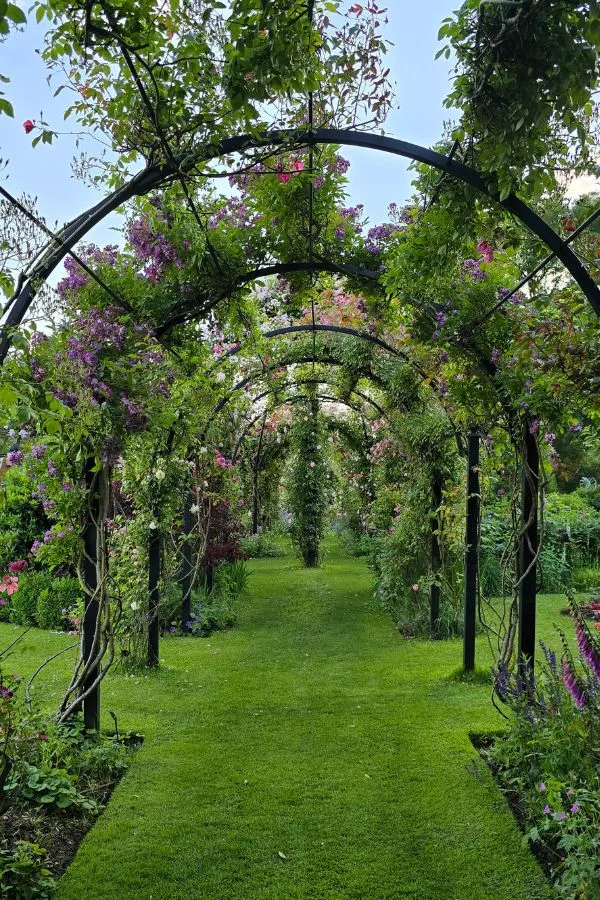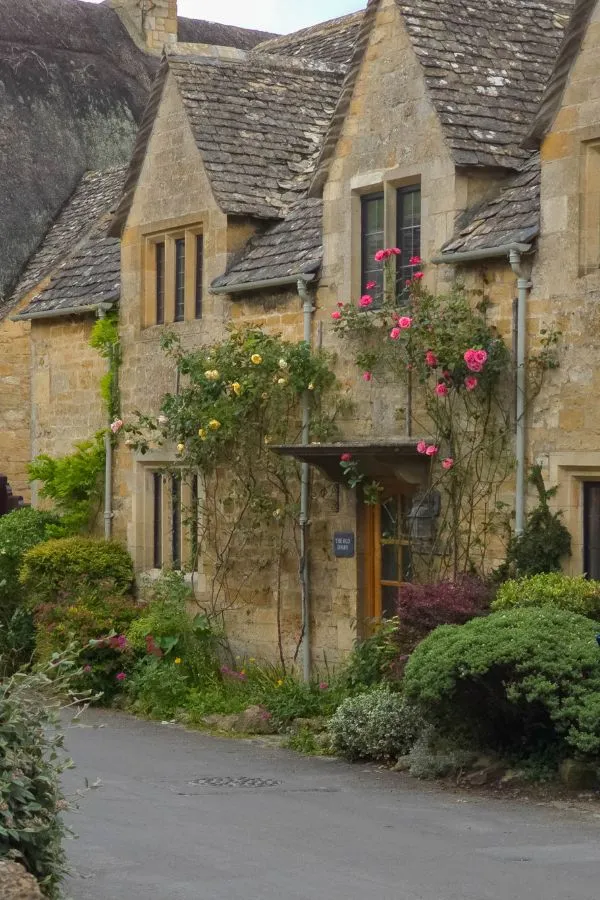A rose garden used to mean a garden planted only with roses.
It was superbly romantic, but the wow factor only lasted a few weeks. Today’s rose gardens combine roses with other plants.
They have all the show-stopping colour and scent of a rose garden, but they weave in perennials, shrubs and trees. So the garden looks good from spring to autumn.
The roses are show-cased on obelisks, pergolas, arches, fences and walls.
A stunning corner of the Peter Beales Classic Roses garden. The pale lilac rambling rose over the bench is Paul’s Himalayan Musk. And the pink rose in the foreground is a shrub rose called ‘Happy Retirement.’ Other shrubs and perennials include potentilla and foxgloves.
So I visited the Peter Beales Classic Roses garden to talk to nursery manager, Ian Limmer, about how to choose the right kind of roses for each type of rose support.
Ian has been growing roses for 46 years, and he was also able to give tips on how to plant roses and what to do about black spot. (You’ll be surprised at the answer, which is at the end of this post).
Use arches, obelisks, pergolas and fences to show off roses. However, you need to know what kind of rose works best on each.
How to choose roses for an obelisk
When I planted up my border, I thought that a climbing rose would be appropriate for an obelisk.
I couldn’t have been more wrong! The Souvenir du Dr. Jamain climber is a beautiful rose, but it does not want to have anything to do with the obelisk. It should have been trained up a wall or fence.
Ian says that first you need to decide where the obelisk will go in the garden. Will it be a small obelisk or a tall one?
Use shrub roses on small obelisks and ‘patio ramblers’ or shrub roses for larger obelisks. The pale pink is a shrub rose called ‘Oxford Physic.’
Are you creating a small ‘rose garden area’ within a larger garden or incorporating roses generally?
He says that shrub roses work well with smaller obelisks. And ‘patio ramblers’ work well on a taller obelisk.
A shrub rose doesn’t exactly climb but the obelisk frames it nicely and there’s enough bulk. If you try to get a climber to go up an obelisk it will just shoot up to the top in a straight line and wave its rose blooms around in the air.

Shrub roses work well on obelisks – this is an 8ft obelisk with a large shrub called Westerland. It has a good scent.
‘Patio ramblers’ are small rambling roses.
What’s the difference between a climbing rose and a rambling rose?
Ian describes the difference between a climbing rose and a rambler: ‘A rambling rose has clusters of small flowers with maybe 20-30 flowers on the end of each stem.
Generally ramblers only flower once, so it gives you a magnificent display just for a few weeks at a time.

Rambling roses, like this Mannington Mauve, have clusters of small flowers. They usually only flower once, but they make a fabulous display.
Climbing roses usually have larger flowers with about three rose flowers to a stem.’ They often repeat flower, although you have to fertilise them to get the best out of them.
Climbing roses always want to shoot upwards. This means you can train them along a wall and several individual shoots will then reach upwards. But they won’t drape over arches the way a rambling rose would.

Climbing rose Souvenir du Dr Jamain in my garden. As you can see, it’s growing almost independently of the obelisk and it’s reaching much taller than the top of the obelisk. A shrub rose would have looked better!
Which roses are best for an arch?
You can add height and vertical interest to a garden or border with an arch.
But choose your rose carefully! If you put climbers on an arch, they may just shoot upwards, says Ian. This may leave the bottom of the arch bare. And they won’t drape over the arch.
If you want a soft, draped effect for a rose garden, then a rambling rose will be better on an arch, according to Ian.
Rambling roses give a soft, draped effect on arches. The red rose is Chevy Chase and the lilac is Mannington Mauve. The pale pink on either side is a patio rambler called Open Arms.
He also thinks that a shrub rose or a small ‘patio rambler’ works well to make sure that the bottom and middle of the arch is covered in roses.
But whatever type of rose you choose, roses won’t grow downwards. So you need to plant a rose on either side of the arch.
What to choose for a rose garden pergola or avenue of rose arches?
If you want a pergola covered in roses or to have an avenue of rose arches, there are a few simple tips to make sure it looks good.
Once again, ramblers and shrub roses will probably work better than climbers.
Firstly Ian says that he recommends planting two of the same type of roses on either side of the first arch. That makes an inviting entrance. ‘Then you can vary it after that, if you like,’ he says.
Don’t let a rose pergola or avenue grow completely over the top if you want grass or plants growing underneath. ‘It’s easy to tie this branch over, then that branch over,’ says Ian. ‘Then you make it completely dark under the pergola.
At Peter Beales Classic Roses, they cut ‘windows’ out of the ‘roof’ of the pergola, so that light can get to all the plants and grass below.

Cut ‘windows’ out of the ‘roof’ of the rose pergola to make sure that enough light gets in below.
Roses for the front of a house
Firstly Ian suggests that you check the size of the rose if you’re planning to grow it up the front of your house or round the door. How high will you want it to grow? A rose for a bungalow is very different from a rose on a three storey house.
Next, he says that when you’re putting a rose on the front of a house – or any wall, it’s good to get your support wires in first.
You should also check the aspect of the wall or the front of your house. A hot south-facing wall may be too hot for happy rose growing, because the wall will make it hotter.
But if you have quite a shady wall, that may be fine. ‘Some roses are quite happy with three or four hours sun a day,’ says Ian.
Once again, if you want a ‘rose arch’ effect with roses round the door, you’ll need two roses on either side.
Ian advises choosing the same roses for each side, because two different roses will always perform differently. ‘You’ll always be comparing – one year one will have better flowers and then another year, it’s the other way round.’

Use climbing roses for the front of a house and put the support wires in before you plant the rose. Ian says that it’s a good idea to have the same rose on either side of the door because sometimes one rose will perform better than the other, but these two look quite well matched.
For walls and up the side of a house, Ian would recommend climbing roses rather than ramblers. If you run wires across the house and tie the new branches in, the climber will produce more shoots going up.
How to choose roses for a fence
Fences are usually between about 4ft and 6ft high. This means that climbers once again will just try to shoot up into the sky. You won’t get that luscious, plumped up effect.
Ian recommends ‘ground cover roses’, shrub roses or ramblers.
‘You could plant a rambler every six feet or so along a hedge, and they’ll grow together. And you can keep ramblers down by cutting them back regularly.
A rose hedge at the Peter Beales Classic Roses garden in Norfolk. Once again, rambling roses generally work better than climbers, and shrub or ground cover roses work well too.
Growing other plants with roses
There are so many plants you can grow with roses, says Ian. At the Peter Beales rose garden, they’ve got roses with grasses, bulbs, perennials and shrubs.
Almost the only thing you need to think about is how the plant height will work with the rose’s height.
And, of course, choose the right plants for your soil type and how much sun that spot in your garden gets.
Ian also thinks the cottage garden effect makes for a good rose garden.
One good tip is to use an arch or obelisk to give the border some height. ‘It’ll make a big difference to the garden,’ he says. It’s also a good way to showcase the roses.
An obelisk in the foreground and an arch in the background are planted with roses, but the plants in the border are mainly perennials.
A bench for a rose garden…
A bench creates a lovely focal point for a rose garden. And, of course, it’s good to have seating around the garden so you can enjoy different views.
A stunning pergola with Paul’s Himalayan Musk and a bench positioned to enjoy its scent.
I asked Ian if people worried about thorns when roses are planted around benches. People do ask for thornless roses, he says, but there are only a few varieties, so you are missing out on hundreds of rose choices if you want thornless ones.
It works better to plant the rose near the bench or within view of the bench, but not so close that you scratch yourself on over-hanging branches.
And, of course, if you’re growing ramblers or climbers, then most of the growth will be overhead.
Do your rose garden research!
Ian says that ‘it’s important to do your homework. Look at the labels on plants before buying them.’
Today’s labels often have quite a lot of information on them, and he says that they’re reliable about, for example, what height a rose might reach.
It’s too easy to buy a plant thinking that it will look good in a certain spot, only to discover that’s not the right place for it. Or that it outgrows the space after just a year or two.
What to do about black spot on roses
Black spot is a fungal disease of roses. The symptoms are black patches on leaves and sometimes many of the leaves drop off altogether.
Many people no longer grow roses because of black spot.
And you will often see gardening advice, suggesting that you spray the roses with fungicides and dispose of the leaves carefully without composting them.
In fact, Ian says that all roses get black spot and ‘it won’t kill them. People think you can have a perfect world, full of plants that don’t have anything wrong with them. But that’s not true.’
Black spot is, however, a symptom of a rose that is struggling. Ian explains that after the first flush of roses, many roses flower again. This uses a huge amount of resources, so you need to feed your roses after first flowering.
Feeding roses won’t clear black spot, but it will mean that the rose can pump out more healthy leaves and flowers. You won’t notice the black spot so much and the plant will be strong enough to resist damage.
The RHS also says that you shouldn’t use fungicides because black spot mutates very quickly, and they have limited effectiveness. It can also damage the biodiversity in your garden.
How to fertilise roses
Ian suggests using a slow release fertiliser in spring. (I use Vitax Organic Rose Fertiliser.)
Then, after the first flush of roses in summer, when you’re dead-heading, put down another application of slow release fertiliser.
But it takes slow release fertiliser a few weeks to break down in the soil, so to fill in the gap, he suggests a liquid feed.
You could use a tomato or seaweed feed – I use one by Envii – or a home-made liquid feed.
Why you should not plant a rose where a rose has grown before
‘Rose sickness’ is a term used to explain why a rose fails to do well when it’s planted to replace a rose that has grown in the same spot.
But rose sickness isn’t a disease. It’s simply that the soil becomes depleted of essential nutrients. Roses are very hungry plants and if they grow in a spot for 20-50 years, they will take everything out of the soil.
However, if you really want to replace a rose with a rose, you can. Ian recommends digging a hole big enough to take a cardboard box (one that holds 12 bottles of wine should be enough!)
Then scatter that soil elsewhere in the garden. It won’t hurt other plants, it’s just not very nutritious. Place the cardboard box in the hole.
Fill it with new topsoil or good soil from elsewhere in the garden, add some garden compost and slow release fertiliser and plant the new rose in it.
The cardboard box will rot down and improve the soil and the rose will get a good start in life.
You will still need to fertilise the rose twice a year.
How to plant a rose
Ian says that you should dig a hole around 8″-10″ square (around a spade’s depth and width). Make sure you don’t plant a V shaped hole as that will compact the roots.
Add some mycorrhizal funghi to the roots, plus a scattering of slow release rose fertiliser to the hole.
Add another handful of fertiliser and mix it with the soil you’re going to return to the hole.
Plant the rose in the soil, making sure that the graft (the knobbly bit just above the roots) is about an inch below the soil.
Backfill with soil and firm the rose in, adding one more handful of fertiliser and scattering it round the roots.

Leave a Reply